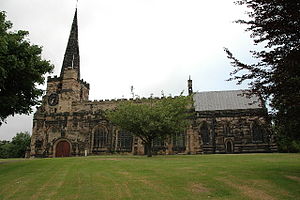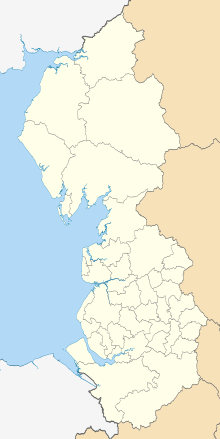| Battle of Winwick | |||||||
|---|---|---|---|---|---|---|---|
| Part of the Second English Civil War | |||||||
 | |||||||
| |||||||
| Belligerents | |||||||
|
| Parliamentarians | ||||||
| Commanders and leaders | |||||||
|
| Oliver Cromwell | ||||||
| Strength | |||||||
|
| ||||||
| Casualties and losses | |||||||
|
| ||||||
North west England (with modern boundaries) | |||||||
The Battle of Winwick (also known as the Battle of Red Bank) was fought on 19 August 1648 near the Lancashire village of Winwick between part of a Royalist army under Lieutenant General William Baillie and a Parliamentarian army commanded by Lieutenant General Oliver Cromwell. The Royalists were defeated with all of those who took part in the fighting, their army's entire infantry force, either killed or captured. The Royalist mounted component fled but surrendered five days after the battle. Winwick was the last battle of the Second English Civil War.
The First English Civil War between Royalist supporters of Charles I and an alliance of Parliamentarian and Scottish forces ended in 1646 with Charles defeated and a prisoner. He continued to negotiate with several factions among his opponents and this sparked the Second English Civil War in 1648: a series of mutinies and Royalist uprisings in England and Wales, and a Scottish Royalist invasion of north-west England. The invading army was attacked and defeated by a smaller Parliamentarian army at the battle of Preston on 17 August. The majority of the Royalists, mostly Scots, had not been engaged but they fled south, closely pursued by the Parliamentarians, mostly of the New Model Army. On 19 August, hungry, cold, soaking wet, exhausted and short of dry powder, the Scottish infantry turned to fight at Winwick. Their cavalry waited 3 miles (5 km) away at Warrington.
The Parliamentarian advance guard was put to flight with heavy casualties. After a lengthy pause, Parliamentarian infantry arrived: they attempted to storm the Scottish position and were thrown back. A full-scale assault was then launched which resulted in more than three hours of furious but indecisive close-quarters fighting. The Parliamentarians fell back again, pinned the Scots in place with their cavalry and sent their infantry on a circuitous flank march. As soon as the Scots saw this force appear on their right flank they broke and fled. Parliamentarian cavalry pursued, killing many. All of the surviving Scots surrendered: their infantry either at Winwick church or in Warrington, their cavalry on 24 August at Uttoxeter. Winwick was the last battle of the war. In its aftermath Charles was beheaded on 30 January 1649 and England became a republic on 19 May.
© MMXXIII Rich X Search. We shall prevail. All rights reserved. Rich X Search

